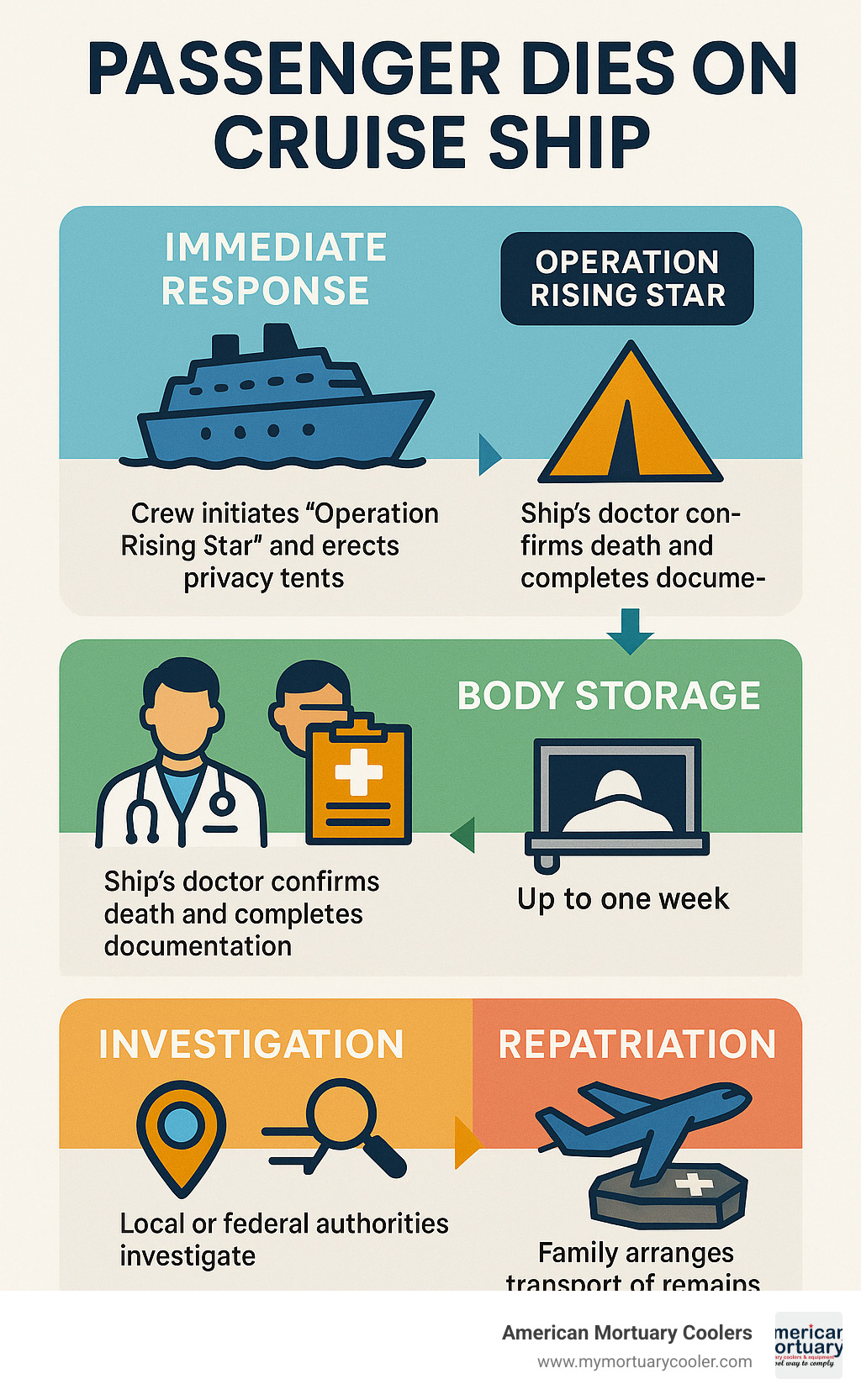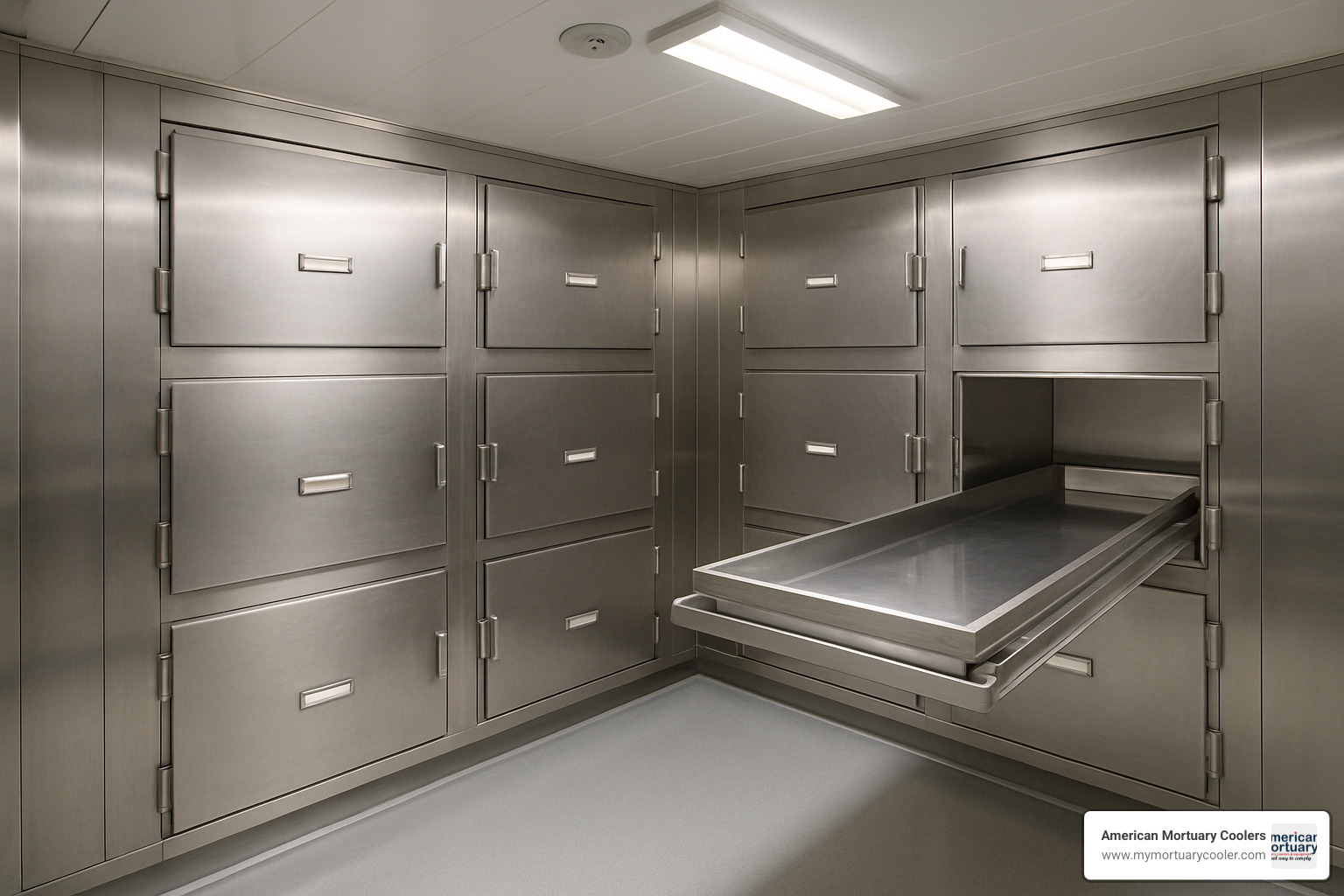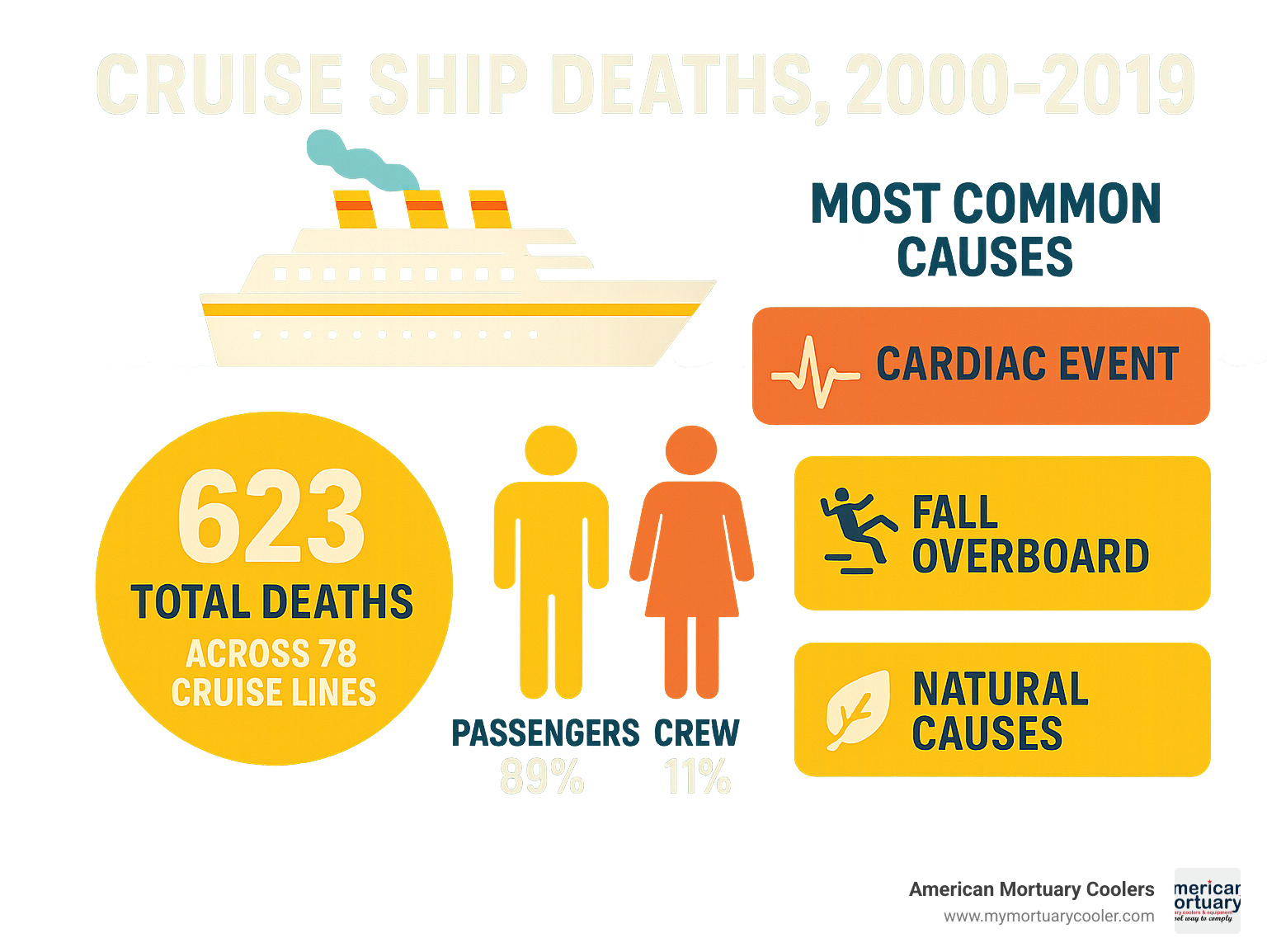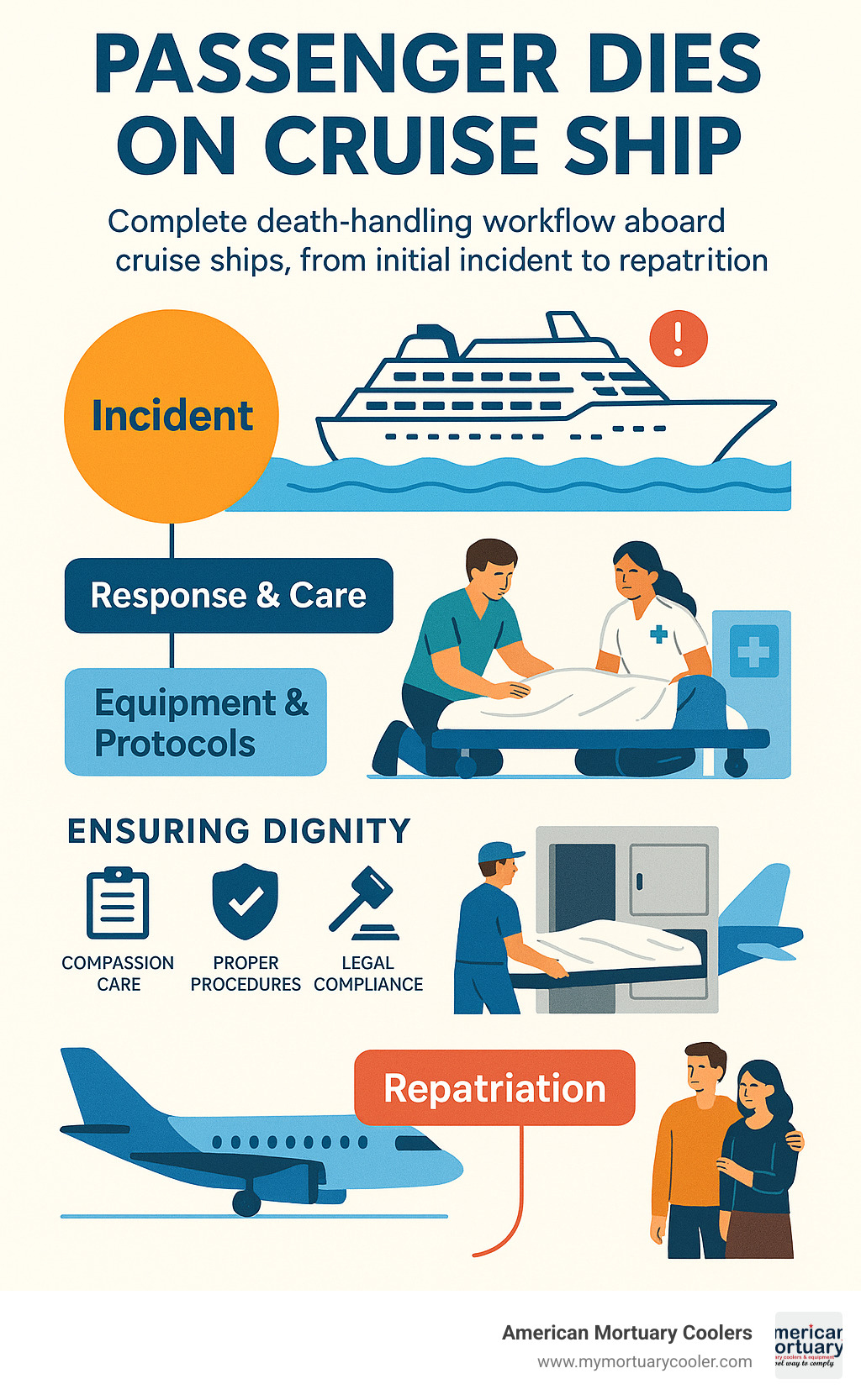Why Understanding Cruise Ship Death Procedures Matters
When a passenger dies on cruise ship, the incident triggers a complex series of protocols involving ship security, medical staff, federal investigators, and international maritime law. Recent cases like the Michael Virgil incident aboard a Royal Caribbean vessel have highlighted the critical importance of proper procedures and equipment when handling deaths at sea.
Quick Facts: What Happens When a Passenger Dies on a Cruise Ship
- Immediate Response: Crew initiates "Operation Rising Star" and erects privacy tents
- Medical Verification: Ship's doctor confirms death and completes documentation
- Body Storage: Remains are placed in the onboard morgue (typically holds 3-6 bodies)
- Investigation: FBI may investigate suspicious deaths; local authorities handle natural causes
- Repatriation: Families arrange body transport at next suitable port
- Timeline: Bodies can be stored onboard for up to one week
- Costs: Families typically pay repatriation expenses (travel insurance recommended)
Between 2000 and 2019, there were 623 deaths reported across 78 cruise lines, with 89% being passengers. While deaths are relatively rare compared to the 30 million people who cruise annually, each incident requires careful handling to preserve dignity and ensure proper investigation.
The recent Royal Caribbean case involving Michael Virgil demonstrates how quickly situations can escalate. Cell phone footage showed the 35-year-old passenger in distress before crew members used zip ties and pepper spray to restrain him. His family claims security injected him with a sedative, and he died within an hour. The FBI has opened an investigation into the circumstances surrounding his death.
We're American Mortuary Coolers, a Tennessee-based company specializing in custom mortuary coolers and related equipment for the funeral industry. Our expertise in temperature-controlled storage solutions helps ensure proper preservation protocols are followed during challenging circumstances, including situations where a passenger dies on cruise ship and other maritime incidents.

The Recent Incident: Passenger Dies on Cruise Ship — What We Know So Far
The death of Michael Virgil aboard a Royal Caribbean cruise ship has become a case study of what can unfold when a passenger dies on cruise ship. The vessel had just departed Los Angeles for Ensenada when events escalated, portions of which were captured on cell-phone video now central to the FBI investigation.
Who Was the Passenger and What Happened?
Virgil, 35, was sailing with his fiancée and 7-year-old son. Witnesses report his behavior turned erratic—loud cursing, kicking cabin doors, and threatening fellow guests. Passenger Christopher Mikhail recalled hearing Virgil say he would kill people on board. Family members insist the outburst was completely out of character and are seeking answers.
Crew Response and Immediate Medical Actions
Security first attempted verbal de-escalation, then used pepper spray and zip-ties when Virgil became physically aggressive. Relatives allege a sedative was injected during the restraint. Despite CPR by medical staff, Virgil was pronounced dead roughly an hour later.
Following protocol, privacy tents shielded the area, the incident was logged, and the captain turned the ship around so federal authorities could board. The FBI collected video, witness statements, and medical documentation to determine whether the death was natural, accidental, or due to excessive force.
Standard Procedures When a Passenger Dies on a Cruise Ship
When someone passes away at sea, cruise lines have well-established procedures that have been refined over decades. These protocols strike a careful balance between maintaining dignity, conducting proper investigations, and handling the practical realities when a passenger dies on cruise ship.
The response starts with coded communications designed to coordinate crew response without alarming other passengers. "Operation Bright Star" signals a serious medical emergency requiring immediate attention, while "Operation Rising Star" confirms that a death has occurred.
Operation Rising Star: Confirming a Passenger Dies on Cruise Ship
Once "Operation Rising Star" is announced over the crew communication system, a carefully coordinated response begins immediately. The ship's doctor - always a qualified physician - must officially confirm the death and begin the required documentation process.
Privacy tents are quickly set up around the deceased to maintain dignity and shield other passengers from the scene. This protects the deceased and their family during an incredibly difficult time, prevents other guests from being traumatized, and gives medical and security personnel the space they need to do their jobs properly.
The crew also follows strict witness protocols during this time. Anyone who saw what happened gives statements that are carefully documented. This information becomes crucial for any investigations that follow.
Onboard Morgue Logistics & Storage Limits

Every cruise ship is required by law to have an onboard morgue, typically located on a lower deck away from passenger areas. These facilities feature stainless-steel refrigerated compartments designed to preserve remains with dignity and respect. Most cruise ship morgues can hold between 3-6 bodies and maintain proper storage conditions for up to one week.
The morgue compartments are kept at temperatures between 36°F and 39°F - the same standards we follow at American Mortuary Coolers when designing our custom storage solutions. This temperature range effectively slows decomposition while preserving the body for eventual transport back home.
U.S. maritime regulations require ships to carry proper body bags and ensure their morgue facilities meet specific health and safety standards. For families dealing with this difficult situation, understanding proper morgue operations can provide some peace of mind. You can learn more about these procedures in our detailed guide on Understanding Cruise Ship Morgue Operations.
Repatriation & Next-of-Kin Notification
When a passenger dies on cruise ship, getting the person's remains back home becomes the immediate priority. The ship's captain must choose the most appropriate port for disstarting the deceased, considering several important factors.
The chosen port must have facilities capable of issuing death certificates and proper funeral services. The captain also considers family preferences, legal requirements of both the ship's flag state and destination country, and practical logistics like available transportation.
Here's something many people don't realize: families are typically responsible for all repatriation costs, which can be quite substantial. This is exactly why travel insurance with repatriation coverage is so important for cruise passengers.
The next-of-kin notification process follows strict protocols, with the ship's passenger services team working closely with grieving families to arrange next steps. If you're facing this difficult situation, our comprehensive resource on The Complete Guide to International Mortuary Shipping: Deceased Remains Shipping Coolers provides valuable information about what to expect during the repatriation process.
Investigations and Legal Jurisdiction at Sea
When a passenger dies on cruise ship, several overlapping legal frameworks come into play. A vessel might be Bahamian-flagged, owned elsewhere, and carrying U.S. citizens in international waters—so responsibility is shared.
Under the U.S. Cruise Vessel Security and Safety Act, suspicious deaths involving Americans must be reported to the FBI. Agents boarded the Royal Caribbean ship on its return to Los Angeles, sealed Virgil’s cabin, and began evidence collection while the Los Angeles County Medical Examiner conducted the autopsy.
Role of the FBI and Flag States in Passenger Dies on Cruise Ship Cases
The FBI investigates possible federal crimes; flag-state officials verify maritime-law compliance; and port authorities assist with logistics. Toxicology reports and medical records guide the final cause-of-death ruling.
Family Rights, Insurance & Potential Lawsuits
The Death on the High Seas Act governs wrongful-death claims beyond U.S. territorial waters. Damages may include medical costs, lost earnings, and repatriation expenses, but some non-economic awards can be limited. Families usually benefit from working with maritime attorneys who understand jurisdictional problems and cruise-line contract clauses.
A recent Celebrity Cruises case—where a body was allegedly stored in a drinks cooler—shows how failure to follow established procedures can still expose cruise lines to liability, reinforcing why professional-grade mortuary equipment is essential.
How Common Are Cruise Ship Deaths? Key Statistics & Causes

When we look at the numbers, deaths at sea are actually quite rare. Between 2000 and 2019, 623 deaths were reported across 78 ocean and river cruise lines. That might sound alarming at first, but consider this: approximately 30 million people take cruises every year. The math shows us that death rates on cruise ships are extremely low compared to the millions of passengers who sail safely each year.
Of those 623 deaths, 89% involved passengers while the remaining 11% were crew members. This breakdown makes sense when you consider that passengers typically outnumber crew members and often include older adults who may have underlying health conditions.
The causes of death when a passenger dies on cruise ship fall into three main categories. Cardiac events top the list, including heart attacks and cardiac arrest. This reflects the demographics of many cruise passengers - often retirees and older adults who are more susceptible to heart-related emergencies.
Falls overboard represent another significant category of cruise ship deaths. These tragic incidents can happen during rough weather, after excessive alcohol consumption, or in rare cases, as intentional acts.
Medical emergencies related to pre-existing conditions also account for many deaths at sea. Despite having medical facilities onboard, cruise ships cannot provide the same level of care as a major hospital. When passengers with serious health conditions experience complications far from shore, outcomes can be tragic.
Less common but still significant are accidents during shore excursions, slip and fall incidents onboard, and unfortunately, suicides and rare homicides.
Preventive Measures for Passengers & Cruise Lines
Cruise lines have learned from these statistics and implemented comprehensive safety measures. Modern ships feature extensive CCTV coverage throughout public areas and corridors. This surveillance helps with both crime prevention and investigation when incidents do occur.
Qualified medical staff and facilities are now standard on all major cruise ships. Most vessels carry defibrillators, emergency medical equipment, and maintain direct communication with shore-based medical facilities.
Security training for crew members has become increasingly sophisticated. The Michael Virgil case highlighted how quickly situations can escalate and the importance of proper restraint techniques.
For passengers, the best protection starts before boarding. Comprehensive travel insurance with medical and repatriation coverage is essential - not just recommended. The costs of medical evacuation or transporting remains can easily reach tens of thousands of dollars.
Health screening and honest disclosure of medical conditions helps cruise medical staff prepare for potential emergencies. Passengers should travel with necessary medications, medical documentation, and emergency contact information easily accessible.
The buddy system approach works particularly well during shore excursions, where many accidents occur. Having someone who knows your whereabouts and can raise an alarm if you don't return as planned has prevented numerous tragedies.
Safety drills and passenger education might seem tedious, but they save lives. Knowing where life jackets are stored, understanding evacuation procedures, and following crew instructions during emergencies can make the difference between life and death.
At American Mortuary Coolers, we understand that despite all these preventive measures, the unfortunate reality is that deaths will continue to occur at sea. That's why proper morgue facilities and temperature-controlled storage remain critical components of cruise ship safety equipment.
What To Do If You Witness or Are Involved in an Onboard Death
Witnessing a situation where a passenger dies on cruise ship can be deeply traumatic. Your priority is safety and rapid notification of the crew—never attempt to manage the scene yourself.
Press the emergency call button in your cabin or alert the nearest crew member, then step back so medical and security teams can act without interference.
Step-by-Step Checklist for Passengers
- Note key details (time, location, people involved) while they are fresh.
- Provide an accurate statement to security and request a copy of the report.
- If safe, take photos that do not obstruct responders.
- Exchange contact information with other witnesses.
- Inform your travel-insurance provider and family at home.
- Use onboard counseling services or seek follow-up care ashore if needed.
- Keep all paperwork—incident reports, emails, photos—in case investigators or insurers request them later.
For post-cruise assistance locating funeral facilities, see A Practical Guide to Finding a Mortuary or Morgue Near You.
Frequently Asked Questions about Passenger Deaths at Sea
When families face the unthinkable situation where a passenger dies on cruise ship, they often have urgent questions about what happens next. These are some of the most common concerns we hear, and understanding the answers can help families steer this difficult time with more clarity.
How long is a body kept on board before disstartation?
The typical timeframe for storing remains onboard is up to one week, though this varies significantly based on circumstances. The ship's morgue facilities are designed to maintain proper preservation during this period, using temperature-controlled compartments similar to the standards we maintain in our custom mortuary coolers.
The ship's captain makes the final decision about when and where to disstart remains. They consider several important factors: whether the port has adequate facilities for handling deceased passengers, if local authorities can issue proper death certificates, and what the family prefers for logistical reasons.
Sometimes a ship might reach a small port that simply doesn't have the right facilities or legal framework to handle a death properly. In these cases, the captain will continue to the next suitable port, even if it means keeping the deceased onboard longer. The priority is always ensuring proper handling and documentation rather than rushing the process.
Who pays the costs of repatriating remains?
This is often the most shocking reality for families - the costs fall entirely on the family, not the cruise line. These expenses can quickly reach tens of thousands of dollars, depending on where the ship is when the death occurs and where the family wants the remains sent.
The costs typically include transportation from the ship to specialized funeral facilities, international shipping with proper temperature control, extensive documentation and legal fees, and sometimes additional hotel stays for family members who need to handle arrangements in foreign ports.
Travel insurance with repatriation coverage becomes absolutely critical in these situations. Many families don't realize how expensive it can be to transport remains internationally until they're facing the reality. Some comprehensive travel policies specifically cover these costs, which can provide enormous relief during an already devastating time.
The cruise line will help coordinate the logistics and provide support, but they don't cover the financial burden. This is why we always recommend that cruise passengers invest in quality travel insurance before they sail.
Can families sue the cruise line for negligence?
Yes, families do have legal options, but maritime law makes these cases uniquely complex. The circumstances surrounding each death determine what legal avenues might be available, and the jurisdictional challenges can be overwhelming for families already dealing with grief.
The Death on the High Seas Act provides the primary framework for wrongful death lawsuits in international waters. However, proving negligence requires showing that the cruise line failed to meet established standards of care or follow proper procedures.
Potential grounds for legal action might include inadequate medical response when emergency care was needed, improper security procedures or use of excessive force during restraint situations, failure to follow established safety protocols, or negligent handling of remains or the subsequent investigation.
The Michael Virgil case we discussed earlier illustrates how these situations can become legally complex. His family's claims about improper use of sedatives and excessive force by security personnel are exactly the types of issues that maritime attorneys evaluate when determining if negligence occurred.
Maritime attorneys specialize in these cases because the legal landscape is so different from typical wrongful death suits on land. They understand the various jurisdictions involved, the specific maritime laws that apply, and how to steer the complex relationship between flag state laws, port authority regulations, and international maritime conventions.
Every situation is different, and families facing these tragic circumstances should consult with experienced maritime legal counsel to understand their specific rights and options.
Conclusion

The reality of what happens when a passenger dies on cruise ship reveals a world most of us never think about until we need to. Behind the scenes of every cruise vacation lies a carefully orchestrated system designed to handle life's most difficult moments with dignity and compassion.
The Michael Virgil case shows us how quickly situations can change at sea. One moment a family is enjoying their vacation, and the next they're dealing with an unimaginable tragedy. While we may never know all the details of what happened that day, his story highlights why proper procedures and equipment matter so much.
The human side of these protocols often gets lost in the technical details. When crew members announce "Operation Rising Star," they're not just following a checklist - they're beginning a process that will affect real families for years to come. The privacy tents, the careful documentation, the respectful handling of remains - every step serves the people left behind who are trying to make sense of their loss.
Temperature-controlled storage becomes critical during these difficult times. The onboard morgues with their stainless-steel compartments aren't just about meeting regulations - they're about giving families the time they need to make arrangements while preserving their loved one's dignity. Those precise temperatures between 36°F and 39°F make all the difference in the world to a grieving family.
As American Mortuary Coolers, we've seen how proper equipment supports families during their darkest hours. Our Tennessee-based team understands that when a passenger dies on cruise ship, every detail matters. The morgue facilities, the transportation coolers, the careful temperature monitoring - these aren't just technical specifications. They're about treating someone's mother, father, spouse, or child with the respect they deserve.
The statistics tell one story - 623 deaths among millions of cruise passengers over two decades. But behind each number is a family trying to steer an impossible situation while dealing with international laws, repatriation costs, and their own grief.
For cruise industry professionals, maintaining proper equipment isn't about checking boxes on an inspection form. It's about being ready when a family needs you most. When someone calls asking about morgue capacity or temperature requirements, they're usually having the worst day of their lives.
The legal complexities surrounding deaths at sea can feel overwhelming, but they exist for good reasons. The FBI investigations, the medical examiner reports, the maritime law requirements - they all work together to ensure families get answers and justice when appropriate.
Looking ahead, the cruise industry continues learning from each incident. The protocols get refined, the equipment gets better, and the training becomes more comprehensive. But at its heart, this is still about people taking care of people during impossible circumstances.
For more information about how proper mortuary equipment supports these critical situations, you can visit our website to learn about our custom solutions for maintaining dignity when it matters most.



















